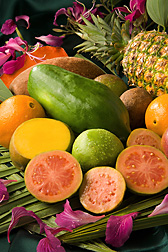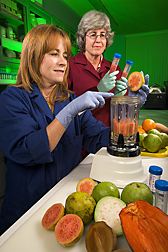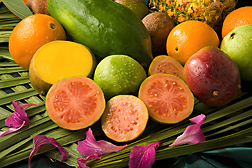Great Guava!
Tropical fruits offer nutrition—
along with color, taste, and variety.
|
|
For years, there’s been a common notion that you get the best nutritional punch from a few well-publicized foods, such as blueberries , black beans, and broccoli. Well, they can move over now and make room for a surprising new addition: guava.
Until recently, only limited information has been available about the nutritional composition of tropical fruits—especially the more exotic ones. But in south Florida, growers are not only producing guava, carambola, mango, papaya, and citrus, but also pitaya, sapodilla, lychee, longan, and mamey sapote. So researchers at the U.S. Citrus and Subtropical Products Research Laboratory at Winter Haven, Florida, have been using standard methods to analyze these fruits for components that could be beneficial to human health.
Heading the effort is the lab’s research leader, horticulturist Liz Baldwin, with ARS scientists John Manthey, Gary Luzio, Anne Plotto, Jan Narciso, and Kevin Goodner and research associate Kanjana Mahattanatawee, in collaboration with scientists at the University of Florida’s Citrus Research and Education Center in Lake Alfred. They’re also cooperating with researchers at Siam University in Bangkok and Chiang Mai University, both in Thailand, where some non-Florida native variations of these same fruits are available for testing. At the lab, they are analyzing all these fruits for phytonutrients, flavor, and several other components.
Rich in Antioxidants
|
|
The function of natural antioxidants and dietary fiber in foods and biological systems has received a lot of attention lately. Fruits and vegetables are playing an increasingly significant role in the daily diet, because many of them provide an optimal mix of antioxidants—such as vitamins C and E, polyphenols, and carotenoids—along with complex carbohydrates and fiber.
Antioxidants are plant chemicals that have the power to neutralize free radicals , which are harmful compounds that are both generated inside human bodies and found in pollutants like cigarette smoke. Reducing free radicals can only improve human health because the oxidative damage they cause to human cells is believed to trigger various chronic diseases. Free-radical damage has been linked to cancer, Alzheimer’s disease, rheumatoid arthritis, cardiovascular disease, cataracts, age-related macular degeneration—and to the aging process itself.
It’s no wonder that nutritionists and scientists have—for years—recommended that we eat five to nine servings of fruits and vegetables each day.
Food writers and marketers have been emphasizing foods known to be high in antioxidants—adding chocolate , oats, onions, soy, spinach, sweet potatoes, tomatoes, and walnuts to the list. The Winter Haven scientists have gone in search of even more high-antioxidant options.
“These specialty tropical fruits are delicious and pack a nutritional punch,” said Baldwin. “They’re a great addition to a healthy diet.”
|
|
Getting at the Good Stuff
Using a variety of methods to analyze for individual nutrients, the researchers have shown that carambola (star fruit), red pitaya (also known as “red dragon”), and mamey sapote are all high in antioxidant compounds called “phenolics,” and mamey sapote is also high in fiber. But the one fruit that beats them all is guava. It had the highest antioxidant potential (measured as ORAC values), total phenolics, vitamin C , and dietary fiber.
ORAC—or oxygen radical absorbance capacity—is a measure of the ability of foods and other compounds to subdue oxygen free radicals. The higher the ORAC value of a food, the more antioxidant power it contains. This is measured by using a 96-well fluorescence microplate reader—an advanced device with high sensitivity and the ability to carry out kinetic studies, such as this one, which require that many ORAC assays be run simultaneously.
Guava’s antioxidant content proved to be around that of orange, grapefruit, and broccoli, and just below that of spinach—all foods that are considered to be high in antioxidants. Other fruits that ranked surprisingly high in antioxidants included lychee and papaya. More detailed results were published in a 2006 issue of the Journal of Agricultural and Food Chemistry.
_________________________________________________
A grant from the Tropical Fruit Growers of South Florida helped fund this research.—By Alfredo Flores, Agricultural Research Service Information Staff.
This research is part of Quality and Utilization of Agricultural Products (#306), an ARS national program described on the World Wide Web at www.nps.ars.usda.gov.
Source: USDA , Agricultural Research service, published Oct 1, 2007.
____________________________________________________






